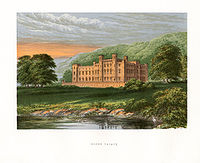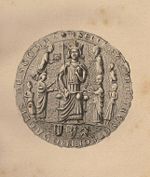
Scone Abbey
Encyclopedia


Augustinians
The term Augustinians, named after Saint Augustine of Hippo , applies to two separate and unrelated types of Catholic religious orders:...
canons
Canon (priest)
A canon is a priest or minister who is a member of certain bodies of the Christian clergy subject to an ecclesiastical rule ....
based at Scone, Perthshire
Perthshire
Perthshire, officially the County of Perth , is a registration county in central Scotland. It extends from Strathmore in the east, to the Pass of Drumochter in the north, Rannoch Moor and Ben Lui in the west, and Aberfoyle in the south...
(Gowrie
Gowrie
Gowrie may refer to several places:* Gowrie, a province in Scotland** Carse of Gowrie, the southern part of Gowrie noted for its farmlandGowrie may also refer to:* Gowrie, Australian Capital Territory, a suburb of Canberra, Australia...
), Scotland
Scotland
Scotland is a country that is part of the United Kingdom. Occupying the northern third of the island of Great Britain, it shares a border with England to the south and is bounded by the North Sea to the east, the Atlantic Ocean to the north and west, and the North Channel and Irish Sea to the...
. Varying dates for the foundation have been given, but it was certainly founded between 1114 and 1122.
The priory was established by six canons from Nostell Priory
Nostell Priory
Nostell Priory is a Palladian house located in Nostell, near Crofton close to Wakefield, West Yorkshire, England, approached by the Doncaster road from Wakefield...
in West Yorkshire
West Yorkshire
West Yorkshire is a metropolitan county within the Yorkshire and the Humber region of England with a population of 2.2 million. West Yorkshire came into existence as a metropolitan county in 1974 after the passage of the Local Government Act 1972....
, under the leadership of Prior Robert
Robert of Scone
Robert of Scone was a 12th century bishop of Cell Rígmonaid . Robert's exact origins are unclear. He was an Augustinian canon at the Priory of St. Oswalds, at Nostell...
, who was the first prior of Scone (later bishop of St Andrews). The foundation charter, dated 1120, was once thought to be spurious but is now regarded as being of late 12th century origin, perhaps the copying owing to the fire which occurred there sometime before 1163 (it would experience a similar destruction of records during the Wars of Scottish Independence
Wars of Scottish Independence
The Wars of Scottish Independence were a series of military campaigns fought between the independent Kingdom of Scotland and the Kingdom of England in the late 13th and early 14th centuries....
).
In either 1163 or 1164, in the reign of King Máel Coluim IV
Malcolm IV of Scotland
Malcolm IV , nicknamed Virgo, "the Maiden" , King of Scots, was the eldest son of Earl Henry and Ada de Warenne...
, Scone Priory's status was increased and it became an abbey. The abbey had important royal functions, being next to the coronation site of Scottish kings and housing the coronation stone
Stone of Scone
The Stone of Scone , also known as the Stone of Destiny and often referred to in England as The Coronation Stone, is an oblong block of red sandstone, used for centuries in the coronation of the monarchs of Scotland and later the monarchs of England, Great Britain and the United Kingdom...
(until it was taken away by King Edward I of England
Edward I of England
Edward I , also known as Edward Longshanks and the Hammer of the Scots, was King of England from 1272 to 1307. The first son of Henry III, Edward was involved early in the political intrigues of his father's reign, which included an outright rebellion by the English barons...
). Scone Abbey was, in the words of King Máel Coluim IV, "in principali sede regni nostri" (RRS, no. 243; trs. "in the principal seat of our kingdom"), and as such was one of the chief residences of the Scottish kings. The abbey would play host to the king while he resided there, even if the abbey did not have a separate palace. It is probable that the abbey buildings (now gone) overlapped with the modern palace
Scone Palace
Scone Palace is a Category A listed historic house at Scone, Perthshire, Scotland. It was constructed in 1808 for the Earls of Mansfield by William Atkinson...
.
The abbey also had relics of the now obscure St Fergus
Saint Fergus
Saint Fergus was an Irish bishop who went to Scotland as a missionary.He settled near Strageath and founded three churches in Strogeth and two in Caithness. He may have also founded churches in Inverugie, Banff, and Dyce...
, which made it a popular pilgrimage centre. Although the abbey would remain famous for its music, the abbey's status declined over time. After the reformation, Scottish abbeys disappeared as institutions.
In Scone's case, it became a secular lordship, first for the Earl of Gowrie
Earl of Gowrie
Earl of Gowrie is a title that has been created twice, once in the Peerage of Scotland and once in the Peerage of the United Kingdom, both times for members of the Ruthven family. It takes its name from Gowrie, a historical region and ancient province of Scotland. On 23 August 1581 William Ruthven,...
, and then to the man who became the first Viscount Stormont. Although the buildings are now gone, the property is now in the possession of the earls of Mansfield.
Scone Abbey flourished for over four hundred years. In 1559 it fell victim to a mob from Dundee during the early days of the Reformation and was largely destroyed. In 1580 the abbey estates were granted to Lord Ruthven
Lord Ruthven
Lord Ruthven may refer to:*Lord Ruthven , the fictional lead character of the 1819 novel The Vampyre.*Lord Ruthven , a title in the Peerage of Scotland - see Earl of Gowrie...
, later the Earl of Gowrie
Earl of Gowrie
Earl of Gowrie is a title that has been created twice, once in the Peerage of Scotland and once in the Peerage of the United Kingdom, both times for members of the Ruthven family. It takes its name from Gowrie, a historical region and ancient province of Scotland. On 23 August 1581 William Ruthven,...
, who held estates around what is now called Huntingtower Castle. The Ruthvens rebuilt the Abbot's Palace of the old abbey as a grand residence. In 1600, James VI charged the family with treason and their estates at Scone were passed to Sir David Murray of Gospetrie, one of James' loyal followers.
The precise location of Scone Abbey had long remained a mystery, but in 2007 archaeologists pinpointed the location using magnetic resonance imaging
Magnetic resonance imaging
Magnetic resonance imaging , nuclear magnetic resonance imaging , or magnetic resonance tomography is a medical imaging technique used in radiology to visualize detailed internal structures...
technology. The find revealed the structure to have been somewhat larger than had been imagined. A stylised illustration of the Abbey on one of its seals suggests that it was a major Romanesque building, with a central tower crowned with a spire.
See also
- Abbot of SconeAbbot of SconeThe Abbot of Scone, before 1163 x 4, Prior of Scone, and then by the beginning of the 16th century, the Commendator of Scone, was the head of the community of Augustinian canons of Scone Abbey and their lands. The priory was established by King Alaxandair mac Maíl Choluim sometime between 1114 and...
, for a list of priors, abbots and commendators

